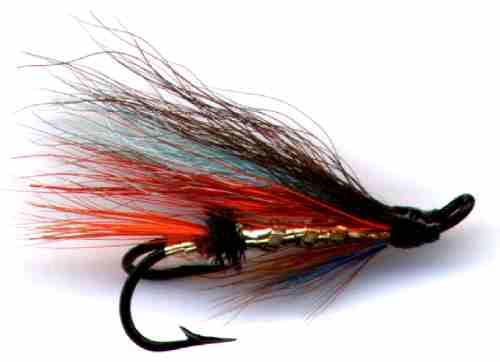The Dunkeld Double Hook Salmon Fly
The Dunkeld Double Hook Salmon fly is one of the very old early 19th century salmon patterns that has undergone considerable change and development over the years.

SALMON DOUBLE HOOK FLY PATTERNS. Hook size 4 6 8 10 - $US each
The Dunkeld should be fished during early summer mornings and late autumn/fall evenings when it has produced some great results. Sea trout fly fishermen always say never use a Dunkeld in late summer as it will always catch a salmon and not a sea trout. This is good news if you are hunting salmon. Try our Dunkeld Single and Double Hook Salmon fly. Choosing the right fly is a problem that occurs for all salmon fly fishers. There is no solid rule that works all the time everywhere. Dark day, dark fly; bright day, bright fly can be a good guide along with high water, big fly; low water, small fly. But sometimes the reverse is true.
Some fly fishermen like to choose a fly of a color that matches the overall color of the riverbed. Rivers that flow over bare rock or limestone are often crystal clear. They may have a blue or green/yellow tinge so some choose flies with the same coloring like Yellow Torrish or the Green Highlander. During early spring and late autumn when the rivers are in full flow after a recent storm try some of the brighter flies. Use garish yellow and orange flies for cold days like. On less cold days use more inconspicuous flies
The Dunkled Fly hits Loch Craggie
I took a few days off to go fishing on Loch Craggie in Sutherland, Scotland last Autumn. The weather forecast predicted strong winds and I needed a place that had sheltered water for boat fishing. Next to the loch is a large mountain called Meall Dora that blocked and dissipated a lot of the winds strength.
I wanted to try out my Dunkeld double hook flies. Although an attractor pattern I believe they are a good imitation of small bait fish. Trout and young salmon are looking to put on weight before the winter and are on the hunt for small fish to munch on.
I had met my fly fishing friend Angus, who lives in Inverness and woks in IT, at the loch shore. We headed for the protected shore. I spied a small bay on the western shore that had weed beds that the local trout loved to hide under.
There is good insect life in this Loch because of the limestone bedrock. The water is not as acidic as other Scottish Highland waters. This mean the fish grow to a reasonable size because of the abundant food. I gave Angus one of my Dunkeld double hook flies to try. He used a long cast a long cast to the left to cover the margins, while I tried he weed bed edge to the left.
I then saw a faded ripple. The deliberate roll of a wide, cream and golden flank right over my Dunkeld fly. I lifted my rod, but instead of stopping with a solid thump, the action simply became a backcast. I waited for the line to straighten behind me and then put the cast back in the same spot. Again a boil and again a missed opportunity. Fish of that size rarely give two chances and never three. Oh well.
We moved along the shore. Every rock and weed bed was a suitable fish lie. We chose a location where a mountain feeder stream entered the loch. It would provide fresh insect fish food that had been washed down from the slopes and fresh oxygenated water that would be a very attractive to the trout.
I cast to the left of the stream and Angus tried the right. We both used the pull pause retrieve to imitate the darting nature of a young bait fish. Angus’s line when tight first. His fish headed for deep water first to try and shake off the fly but then came back towards the boat. After a four minute fight I managed to land the one pound fighting demon in the net.
I was next to get a hook up. My one engulfed the Dunkeld fly and headed for cover of the boulders. I gave him some slack. He changed direction and headed for deep water. I regained contact with him by flattening my line moving my rod tip to the side. It was another good sized highland loch trout. This time Angus did the honours with the landing net. We managed to catch a further five fish between us.
In Autumn I am a firm believer in using fish that look like small juvenile bait fish rather than flies that imitate Aquatic insects. The trout are looking to put on weight before the winter and the best way to do this is to prey on smaller fish as they have a high calorific value.
The Dunkeld fly pattern is an attractor fly but I think it imitates Highland loch juvenile fish. Its gold body looks like the scales of a fish’s belly and the dark hair wing matches their dark coloured backs. The use of hair as a wing material adds natural life like movement to the pattern which fools many fish to thinking that it represents a good meal.

